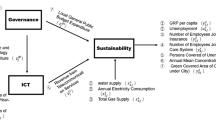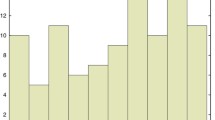Abstract
Decision-making quality is a concern for the public sector because its decisions may involve more dimensions than those faced by the private sector. However, past studies on public sector efficiency have ignored the uncertainty of data estimation. This study addresses this shortcoming by proposing a chance-constrained network DEA approach based on an enhanced Russell-based directional distance measure that evaluates public sector performance. The proposed approach uses stochastic inputs and outputs to enhance decision-making quality and capacity in the public sector. The usefulness of this approach is demonstrated through an empirical case of the OECD. Our approach also provides practical suggestions for promoting a green economic transformation and serves as a reference for government policies.





Similar content being viewed by others
References
Adam, A., Delis, M. D., & Kammas, P. (2013). Fiscal decentralization and public sector efficiency: Evidence from OECD countries. Economics of Governance, 15(1), 17–49. https://doi.org/10.1007/s10101-013-0131-4
Afzalinejad, M. (2021). Evaluating radial efficiency considering environmental factors: A generalization of classical DEA. Measurement. https://doi.org/10.1016/j.measurement.2021.109497
Arbolino, R., Boffardi, R., Ioppolo, G., Lantz, T., & Rosa, P. (2022). Evaluating industrial sustainability in OECD countries: A cross-country comparison. Journal of Cleaner Production, 331, 129773.
Aye, G. C., Gupta, R., & Wanke, P. (2018). Energy efficiency drivers in South Africa: 1965–2014. Energy Efficiency, 11(6), 1465–1482.
Chen, P.-C., & Yu, M.-M. (2014). Total factor productivity growth and directions of technical change bias: Evidence from 99 OECD and non-OECD countries. Annals of Operations Research, 214(1), 143–165.
Cherchye, L., De Witte, K., Ooghe, E., & Nicaise, I. (2010). Efficiency and equity in private and public education: A nonparametric comparison. European Journal of Operational Research, 202(2), 563–573. https://doi.org/10.1016/j.ejor.2009.06.015
Christl, M., Köppl-Turyna, M., & Kucsera, D. (2020). Determinants of public-sector efficiency: decentralization and fiscal rules. Kyklos, 73(2), 253–290.
Costa-Campi, M. T., Garcia-Quevedo, J., & Martínez-Ros, E. (2017). What are the determinants of investment in environmental R&D? Energy Policy, 104, 455–465.
Galagedera, D. U. A. (2017). Modelling superannuation fund management function as a two-stage process for overall and stage-level performance appraisal. Applied Economics, 50(22), 2439–2458. https://doi.org/10.1080/00036846.2017.1400649
Guccio, C., Martorana, M., Mazza, I., Pignataro, G., & Rizzo, I. (2020). An assessment of the performance of Italian public historical archives: Preservation vs utilisation. Journal of Policy Modeling, 42(6), 1270–1286.
Gunasekaran, A., Irani, Z., & Papadopoulos, T. (2014). Modelling and analysis of sustainable operations management: Certain investigations for research and applications. Journal of the Operational Research Society, 65(6), 806–823.
Izadikhah, M., & Saen, R. F. (2018). Assessing sustainability of supply chains by chance-constrained two-stage DEA model in the presence of undesirable factors. Computers & Operations Research, 100, 343–367.
Kava, H., Spanaki, K., Papadopoulos, T., Despoudi, S., Rodriguez-Espindola, O., & Fakhimi, M. (2021). Data analytics diffusion in the UK renewable energy sector: An innovation perspective. Annals of Operations Research. https://doi.org/10.1007/s10479-021-04263-1
Kaya Samut, P., & Cafrı, R. (2015). Analysis of the efficiency determinants of health systems in OECD countries by DEA and panel tobit. Social Indicators Research, 129(1), 113–132. https://doi.org/10.1007/s11205-015-1094-3
Keskin, B. (2021). An efficiency analysis on social prosperity: OPEC case under network DEA slack-based measure approach. Energy. https://doi.org/10.1016/j.energy.2021.120832
Khodadadipour, M., Hadi-Vencheh, A., Behzadi, M. H., & Rostamy-malkhalifeh, M. (2021). Undesirable factors in stochastic DEA cross-efficiency evaluation: An application to thermal power plant energy efficiency. Economic Analysis and Policy, 69, 613–628. https://doi.org/10.1016/j.eap.2021.01.013
Kitamori, K., Manders, T., Dellink, R., & Tabeau, A. (2012). OECD environmental outlook to 2050: the consequences of inaction (9264122168). Retrieved from
Kuosmanen, T., Zhou, X., & Dai, S. J. W. D. (2020). How much climate policy has cost for OECD countries?, 125, 104681.
Land, K. C., Lovell, C. K., & Thore, S. (1993). Chance-constrained data envelopment analysis. Managerial and Decision Economics, 14(6), 541–554.
Le, P. T., & Nguyen, H.-O. (2020). Influence of policy, operational and market conditions on seaport efficiency in newly emerging economies: The case of Vietnam. Applied Economics, 52(43), 4698–4710.
Lin, F. Y., Lin, S. W., & Lu, W. M. (2018). Sustainability assessment of Taiwan’s semiconductor industry: A new hybrid model using combined analytic hierarchy process and two-stage additive network data envelopment analysis. Sustainability. https://doi.org/10.3390/su10114070
Mavi, N. K., & Mavi, R. K. (2019). Energy and environmental efficiency of OECD countries in the context of the circular economy: Common weight analysis for malmquist productivity index. Journal of Environmental Management, 247, 651–661.
Moheb-Alizadeh, H., & Handfield, R. (2018). An integrated chance-constrained stochastic model for efficient and sustainable supplier selection and order allocation. International Journal of Production Research, 56(21), 6890–6916. https://doi.org/10.1080/00207543.2017.1413258
Mohmmad Nejad, Z., & Ghaffari-Hadigheh, A. (2018). A novel DEA model based on uncertainty theory. Annals of Operations Research, 264(1), 367–389.
Mohsin, M., Hanif, I., Taghizadeh-Hesary, F., Abbas, Q., & Iqbal, W. (2021). Nexus between energy efficiency and electricity reforms: A DEA-based way forward for clean power development. Energy Policy. https://doi.org/10.1016/j.enpol.2020.112052
Moon, H., & Min, D. (2020). A DEA approach for evaluating the relationship between energy efficiency and financial performance for energy-intensive firms in Korea. Journal of Cleaner Production. https://doi.org/10.1016/j.jclepro.2020.120283
Nasseri, S. H., Ebrahimnejad, A., & Gholami, O. (2018). Fuzzy stochastic data envelopment analysis with undesirable outputs and its application to banking industry. International Journal of Fuzzy Systems, 20(2), 534–548.
Nicolli, F., & Vona, F. (2019). Energy market liberalization and renewable energy policies in OECD countries. Energy Policy, 128, 853–867.
Olesen, O. B., & Petersen, N. C. (2016). Stochastic data envelopment analysis—A review. European Journal of Operational Research, 251(1), 2–21.
Oppi, C., Campanale, C., & Cinquini, L. (2022). Ambiguity in public sector performance measurement: A systematic literature review. Journal of Public Budgeting, Accounting & Financial Management, 34(3), 370–390.
Ozcan, B., Tzeremes, P. G., & Tzeremes, N. G. J. E. M. (2020). Energy consumption, economic growth and environmental degradation in OECD countries. 84, 203–213.
Paramati, S. R., Shahzad, U., & Doğan, B. (2022). The role of environmental technology for energy demand and energy efficiency: Evidence from OECD countries. Renewable and Sustainable Energy Reviews, 153, 111735.
Park, S., Ok, C., & Ha, C. (2018). A stochastic simulation-based holistic evaluation approach with DEA for vendor selection. Computers & Operations Research, 100, 368–378.
Rietig, K. J. E. P. (2019). The importance of compatible beliefs for effective climate policy integration. 28(2), 228–247.
Seiford, L. M., & Zhu, J. (2002). Modeling undesirable factors in efficiency evaluation. European Journal of Operational Research, 142(1), 16–20.
Shen, Z., Boussemart, J.-P., & Leleu, H. (2017). Aggregate green productivity growth in OECD’s countries. International Journal of Production Economics, 189, 30–39. https://doi.org/10.1016/j.ijpe.2017.04.007
Tavassoli, M., Fathi, A., & Farzipoor Saen, R. (2021). Developing a new super-efficiency DEA model in the presence of both zero data and stochastic data: A case study in the Iranian airline industry. Benchmarking: an International Journal, 28(1), 42–65.
Wang, R., Wang, Q., & Yao, S. (2021). Evaluation and difference analysis of regional energy efficiency in China under the carbon neutrality targets: Insights from DEA and Theil models. Journal of Environmental Management, 293, 112958.
Wanke, P., Barros, C. P., & Emrouznejad, A. (2016). Assessing productive efficiency of banks using integrated Fuzzy-DEA and bootstrapping: A case of Mozambican banks. European Journal of Operational Research, 249(1), 378–389.
Yadava, A. K., & Neog, Y. (2022). Public sector performance and efficiency assessment of Indian states. Global Business Review, 23(2), 493–511.
Yu, D., & He, X. (2020). A bibliometric study for DEA applied to energy efficiency: Trends and future challenges. Applied Energy. https://doi.org/10.1016/j.apenergy.2020.115048
Zakari, A., Khan, I., Tan, D., Alvarado, R., & Dagar, V. (2022). Energy efficiency and sustainable development goals (SDGs). Energy, 239, 122365.
Zhang, C., & Chen, P. (2022). Applying the three-stage SBM-DEA model to evaluate energy efficiency and impact factors in RCEP countries. Energy. https://doi.org/10.1016/j.energy.2021.122917
Zhao, X., Ma, X., Shang, Y., Yang, Z., & Shahzad, U. (2022). Green economic growth and its inherent driving factors in Chinese cities: Based on the Metafrontier-global-SBM super-efficiency DEA model. Gondwana Research, 106, 315–328.
Zhou, X., Xu, Z., Chai, J., Yao, L., Wang, S., & Lev, B. (2019). Efficiency evaluation for banking systems under uncertainty: A multi-period three-stage DEA model. Omega, 85, 68–82.
Funding
This research was supported by the Ministry of Science and Technology, Taiwan, R.O.C. under Grant No. MOST111-2410-H-606–003 and MOST110-2410-H-034–021-MY3.
Author information
Authors and Affiliations
Corresponding author
Ethics declarations
Conflict of interests
The authors declare that they have no conflicts of interest.
Animal and Human participants
This article does not contain any studies involving human participants performed by any of the authors.
Additional information
Publisher's Note
Springer Nature remains neutral with regard to jurisdictional claims in published maps and institutional affiliations.
Rights and permissions
Springer Nature or its licensor (e.g. a society or other partner) holds exclusive rights to this article under a publishing agreement with the author(s) or other rightsholder(s); author self-archiving of the accepted manuscript version of this article is solely governed by the terms of such publishing agreement and applicable law.
About this article
Cite this article
Lin, SW., Lu, WM. A chance-constrained network DEA approach based on enhanced Russell-based directional distance measure to evaluate public sector performance: a case study of OECD countries. Ann Oper Res (2023). https://doi.org/10.1007/s10479-023-05337-y
Accepted:
Published:
DOI: https://doi.org/10.1007/s10479-023-05337-y




